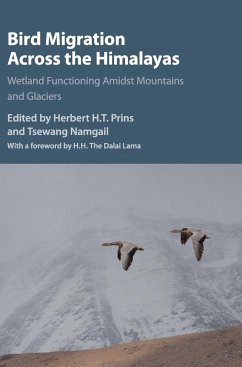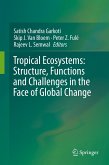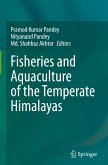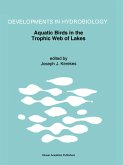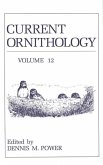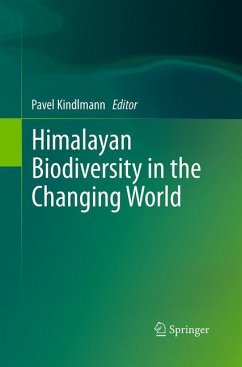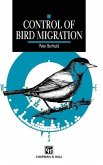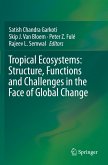Bird Migration across the Himalayas
Herausgeber: Prins, Herbert H. T.; Namgail, Tsewang
Bird Migration across the Himalayas
Herausgeber: Prins, Herbert H. T.; Namgail, Tsewang
- Gebundenes Buch
- Merkliste
- Auf die Merkliste
- Bewerten Bewerten
- Teilen
- Produkt teilen
- Produkterinnerung
- Produkterinnerung
The first reference to demonstrate how birds survive the high-altitude Central Asian Flyway and the threats to this unique migration.
Andere Kunden interessierten sich auch für
![Tropical Ecosystems: Structure, Functions and Challenges in the Face of Global Change Tropical Ecosystems: Structure, Functions and Challenges in the Face of Global Change]() Tropical Ecosystems: Structure, Functions and Challenges in the Face of Global Change137,99 €
Tropical Ecosystems: Structure, Functions and Challenges in the Face of Global Change137,99 €![Fisheries and Aquaculture of the Temperate Himalayas Fisheries and Aquaculture of the Temperate Himalayas]() Fisheries and Aquaculture of the Temperate Himalayas132,99 €
Fisheries and Aquaculture of the Temperate Himalayas132,99 €![Aquatic Birds in the Trophic Web of Lakes Aquatic Birds in the Trophic Web of Lakes]() Aquatic Birds in the Trophic Web of Lakes242,99 €
Aquatic Birds in the Trophic Web of Lakes242,99 €![Current Ornithology Current Ornithology]() Current Ornithology42,99 €
Current Ornithology42,99 €![Himalayan Biodiversity in the Changing World Himalayan Biodiversity in the Changing World]() Himalayan Biodiversity in the Changing World121,99 €
Himalayan Biodiversity in the Changing World121,99 €![Control of Bird Migration Control of Bird Migration]() P. BertholdControl of Bird Migration166,99 €
P. BertholdControl of Bird Migration166,99 €![Tropical Ecosystems: Structure, Functions and Challenges in the Face of Global Change Tropical Ecosystems: Structure, Functions and Challenges in the Face of Global Change]() Tropical Ecosystems: Structure, Functions and Challenges in the Face of Global Change137,99 €
Tropical Ecosystems: Structure, Functions and Challenges in the Face of Global Change137,99 €-
-
-
The first reference to demonstrate how birds survive the high-altitude Central Asian Flyway and the threats to this unique migration.
Hinweis: Dieser Artikel kann nur an eine deutsche Lieferadresse ausgeliefert werden.
Hinweis: Dieser Artikel kann nur an eine deutsche Lieferadresse ausgeliefert werden.
Produktdetails
- Produktdetails
- Verlag: Cambridge University Press
- Seitenzahl: 492
- Erscheinungstermin: 14. Februar 2018
- Englisch
- Abmessung: 250mm x 175mm x 31mm
- Gewicht: 1020g
- ISBN-13: 9781107114715
- ISBN-10: 1107114713
- Artikelnr.: 48060661
- Herstellerkennzeichnung
- Libri GmbH
- Europaallee 1
- 36244 Bad Hersfeld
- gpsr@libri.de
- Verlag: Cambridge University Press
- Seitenzahl: 492
- Erscheinungstermin: 14. Februar 2018
- Englisch
- Abmessung: 250mm x 175mm x 31mm
- Gewicht: 1020g
- ISBN-13: 9781107114715
- ISBN-10: 1107114713
- Artikelnr.: 48060661
- Herstellerkennzeichnung
- Libri GmbH
- Europaallee 1
- 36244 Bad Hersfeld
- gpsr@libri.de
Forward; Preface; Introduction; Part I. Migratory Routes and Movement
Ecology: 1. Goose migration across the Himalayas: migratory routes and
movement patterns of bar-headed geese; 2. Himalayan thoroughfare: migratory
routes of ducks over the rooftop of the world; 3. Migratory routes across
the Himalayas used by Demoiselle Cranes; 4. Passerine migration across the
Himalayas; 5. Wader migration across the Himalayas; 6. Raptor migration
across and around the Himalayas; 7. Steppe Eagle migration from Mongolia to
India; 8. Peregrine Falcons crossing the 'Roof of the World'; Part II.
Physiography of the Highest Barrier on Earth: 9. Geological origin and
evolution of the Himalayas; 10. Late Quaternary glacier fluctuations in the
Himalayas and adjacent mountains; 11. The influence of hydrology and
glaciology on wetlands in the Himalayas; 12. The Himalayan vegetation along
horizontal and vertical gradients; 13. Assessing the evidence for changes
in vegetation phenology in high altitude wetlands of Ladakh (2002-2015);
Part III. High-Altitude Migration Strategies: 14. The wind system in the
Himalayas: from a bird's-eye view; 15. Birds, gliders and uplift systems
over the Himalayas; 16. Goose migration over the Himalayas: physiological
adaptations; 17. Distance-altitude trade off may explain why some migratory
birds fly over and not around the Himalayas; 18. Refuelling stations for
waterbirds: macroinvertebrate biomass in relation to altitude in the
Trans-Himalayas; 19. The Himalayas as an ecological barrier for avian
migrants: high and dry, but also dangerous?; 20. Bird species diversity on
an elevational gradient between the Greater Himalaya and the Tibetan
Plateau; Part IV. People and their Effects on the Himalayas: 21. Evidence
of human presence in the Himalayan mountains: new insights from
petroglyphs; 22. Pastoralism and wetland resources in Ladakh's Changthang
plateau; 23. Impacts of tourism and military presence on wetlands and their
avifauna in the Himalayas; 24. Birds in relation to farming and livestock
grazing in the Indian Trans-Himalaya; 25. Migratory ducks and protected
wetlands in India; 26. A network of small, dispersed Himalayan wetlands
suitable for designation under the Ramsar Convention; Part V. Conclusions:
27. Bird migration across the Himalayas and beyond: the need for better
conservation and management of a natural wonder; Appendix. Locations
(places, mountains, rivers, etc.) mentioned in the chapters and their
geographic coordinates.
Ecology: 1. Goose migration across the Himalayas: migratory routes and
movement patterns of bar-headed geese; 2. Himalayan thoroughfare: migratory
routes of ducks over the rooftop of the world; 3. Migratory routes across
the Himalayas used by Demoiselle Cranes; 4. Passerine migration across the
Himalayas; 5. Wader migration across the Himalayas; 6. Raptor migration
across and around the Himalayas; 7. Steppe Eagle migration from Mongolia to
India; 8. Peregrine Falcons crossing the 'Roof of the World'; Part II.
Physiography of the Highest Barrier on Earth: 9. Geological origin and
evolution of the Himalayas; 10. Late Quaternary glacier fluctuations in the
Himalayas and adjacent mountains; 11. The influence of hydrology and
glaciology on wetlands in the Himalayas; 12. The Himalayan vegetation along
horizontal and vertical gradients; 13. Assessing the evidence for changes
in vegetation phenology in high altitude wetlands of Ladakh (2002-2015);
Part III. High-Altitude Migration Strategies: 14. The wind system in the
Himalayas: from a bird's-eye view; 15. Birds, gliders and uplift systems
over the Himalayas; 16. Goose migration over the Himalayas: physiological
adaptations; 17. Distance-altitude trade off may explain why some migratory
birds fly over and not around the Himalayas; 18. Refuelling stations for
waterbirds: macroinvertebrate biomass in relation to altitude in the
Trans-Himalayas; 19. The Himalayas as an ecological barrier for avian
migrants: high and dry, but also dangerous?; 20. Bird species diversity on
an elevational gradient between the Greater Himalaya and the Tibetan
Plateau; Part IV. People and their Effects on the Himalayas: 21. Evidence
of human presence in the Himalayan mountains: new insights from
petroglyphs; 22. Pastoralism and wetland resources in Ladakh's Changthang
plateau; 23. Impacts of tourism and military presence on wetlands and their
avifauna in the Himalayas; 24. Birds in relation to farming and livestock
grazing in the Indian Trans-Himalaya; 25. Migratory ducks and protected
wetlands in India; 26. A network of small, dispersed Himalayan wetlands
suitable for designation under the Ramsar Convention; Part V. Conclusions:
27. Bird migration across the Himalayas and beyond: the need for better
conservation and management of a natural wonder; Appendix. Locations
(places, mountains, rivers, etc.) mentioned in the chapters and their
geographic coordinates.
Forward; Preface; Introduction; Part I. Migratory Routes and Movement
Ecology: 1. Goose migration across the Himalayas: migratory routes and
movement patterns of bar-headed geese; 2. Himalayan thoroughfare: migratory
routes of ducks over the rooftop of the world; 3. Migratory routes across
the Himalayas used by Demoiselle Cranes; 4. Passerine migration across the
Himalayas; 5. Wader migration across the Himalayas; 6. Raptor migration
across and around the Himalayas; 7. Steppe Eagle migration from Mongolia to
India; 8. Peregrine Falcons crossing the 'Roof of the World'; Part II.
Physiography of the Highest Barrier on Earth: 9. Geological origin and
evolution of the Himalayas; 10. Late Quaternary glacier fluctuations in the
Himalayas and adjacent mountains; 11. The influence of hydrology and
glaciology on wetlands in the Himalayas; 12. The Himalayan vegetation along
horizontal and vertical gradients; 13. Assessing the evidence for changes
in vegetation phenology in high altitude wetlands of Ladakh (2002-2015);
Part III. High-Altitude Migration Strategies: 14. The wind system in the
Himalayas: from a bird's-eye view; 15. Birds, gliders and uplift systems
over the Himalayas; 16. Goose migration over the Himalayas: physiological
adaptations; 17. Distance-altitude trade off may explain why some migratory
birds fly over and not around the Himalayas; 18. Refuelling stations for
waterbirds: macroinvertebrate biomass in relation to altitude in the
Trans-Himalayas; 19. The Himalayas as an ecological barrier for avian
migrants: high and dry, but also dangerous?; 20. Bird species diversity on
an elevational gradient between the Greater Himalaya and the Tibetan
Plateau; Part IV. People and their Effects on the Himalayas: 21. Evidence
of human presence in the Himalayan mountains: new insights from
petroglyphs; 22. Pastoralism and wetland resources in Ladakh's Changthang
plateau; 23. Impacts of tourism and military presence on wetlands and their
avifauna in the Himalayas; 24. Birds in relation to farming and livestock
grazing in the Indian Trans-Himalaya; 25. Migratory ducks and protected
wetlands in India; 26. A network of small, dispersed Himalayan wetlands
suitable for designation under the Ramsar Convention; Part V. Conclusions:
27. Bird migration across the Himalayas and beyond: the need for better
conservation and management of a natural wonder; Appendix. Locations
(places, mountains, rivers, etc.) mentioned in the chapters and their
geographic coordinates.
Ecology: 1. Goose migration across the Himalayas: migratory routes and
movement patterns of bar-headed geese; 2. Himalayan thoroughfare: migratory
routes of ducks over the rooftop of the world; 3. Migratory routes across
the Himalayas used by Demoiselle Cranes; 4. Passerine migration across the
Himalayas; 5. Wader migration across the Himalayas; 6. Raptor migration
across and around the Himalayas; 7. Steppe Eagle migration from Mongolia to
India; 8. Peregrine Falcons crossing the 'Roof of the World'; Part II.
Physiography of the Highest Barrier on Earth: 9. Geological origin and
evolution of the Himalayas; 10. Late Quaternary glacier fluctuations in the
Himalayas and adjacent mountains; 11. The influence of hydrology and
glaciology on wetlands in the Himalayas; 12. The Himalayan vegetation along
horizontal and vertical gradients; 13. Assessing the evidence for changes
in vegetation phenology in high altitude wetlands of Ladakh (2002-2015);
Part III. High-Altitude Migration Strategies: 14. The wind system in the
Himalayas: from a bird's-eye view; 15. Birds, gliders and uplift systems
over the Himalayas; 16. Goose migration over the Himalayas: physiological
adaptations; 17. Distance-altitude trade off may explain why some migratory
birds fly over and not around the Himalayas; 18. Refuelling stations for
waterbirds: macroinvertebrate biomass in relation to altitude in the
Trans-Himalayas; 19. The Himalayas as an ecological barrier for avian
migrants: high and dry, but also dangerous?; 20. Bird species diversity on
an elevational gradient between the Greater Himalaya and the Tibetan
Plateau; Part IV. People and their Effects on the Himalayas: 21. Evidence
of human presence in the Himalayan mountains: new insights from
petroglyphs; 22. Pastoralism and wetland resources in Ladakh's Changthang
plateau; 23. Impacts of tourism and military presence on wetlands and their
avifauna in the Himalayas; 24. Birds in relation to farming and livestock
grazing in the Indian Trans-Himalaya; 25. Migratory ducks and protected
wetlands in India; 26. A network of small, dispersed Himalayan wetlands
suitable for designation under the Ramsar Convention; Part V. Conclusions:
27. Bird migration across the Himalayas and beyond: the need for better
conservation and management of a natural wonder; Appendix. Locations
(places, mountains, rivers, etc.) mentioned in the chapters and their
geographic coordinates.

